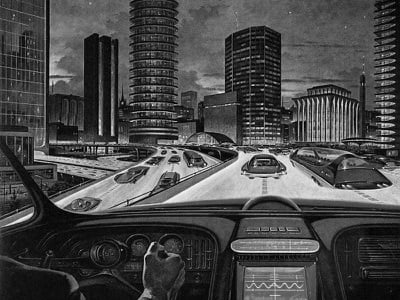At this junction in history, Advanced Driver Assistance Systems (ADAS) and other on-board electronic systems are not only a reality; they are a dominating presence within vehicle development programs. Sophisticated sensor-plus-intelligence features that have been on the concept board for decades have already been successfully introduced via high-end vehicles, and are now commonplace in city cars – e.g. Automatic Emergency Braking (AEB). ADAS-type sensors and information processing technologies are also on the forward edge of autonomous vehicle control – literally and figuratively.
In order to properly develop the emerging new relationships between drivers and vehicles that is a consequence of these innovations, leading auto manufacturers are employing new technologies that place real human beings at the center of the process. Engineering class, dynamics-capable Driver-in-the-Loop (DIL) simulators are allowing expert and non-expert drivers to safely climb behind the wheel of new vehicle models, long before physical prototypes are even available, and at the time when it is most needed – early in the development process, when the interactions between the driver and on-board systems are being formulated.
DIL simulators themselves are nothing new, of course – They have been used in the automotive industry for more than 30 years. However, the specific class of DIL simulators that is now emerging is quite different, often employing as much sophisticated technology as cars themselves.
DIL Simulators for Vehicle Engineering
It’s a given that automakers require offline Software-in-the-Loop (SIL) and Hardware-in-the-Loop (HIL) simulation tools when developing on-board vehicle systems. But there is a void. Off-line studies do not include subjective assessments, and at the end of the day, vehicles are primarily judged based on how well they ride and drive. The addition of dynamics-capable DIL simulators to the process introduces entirely new possibilities that are fundamental to creating vehicles that are a pleasure to drive, inspiring owner confidence and enthusiasm.
Legacy DIL simulators were used primarily for human factors studies where the specifics of a vehicle’s interaction with its environment could be approximated or generalized. For example, a “classic” driver distraction DIL experiment might not require detailed modelling of tire/surface force relationships or photo-realism of a surrounding scene, and the participant drivers might not need expert-level driving skills. Nowadays experiments may very well require these things and more. Let’s take a look at two general types of DIL experiments in view of the new landscape of ADAS and on-board system development.
-
Common Driver, Sophisticated Scenario: How can non-expert drivers ‘handshake’ with various on-board systems? This is a major area of focus for auto manufacturers. At one end of the spectrum is conflict resolution, where vehicle control algorithms fed by unexpected driver behaviors and environment conditions have the potential to induce collisions or (roadway) departures rather than prevent them. At the other end of the spectrum is the intricacy of full handovers between human drivers and artificial intelligences. Both cases, and many others in between, simultaneously involve complex environmental scenarios and human behaviors. In order for a DIL simulator to be a useful tool in these cases, it must embrace modelling and computational complexity rather than run away from it. Human drivers must be informed and stimulated to the extent that they behave realistically; vehicle on-board system performance (be it SIL-generated or HIL-generated or a combination) must be correct.
-
Skilled Driver, Simple Scenario: How can expert drivers ‘shakedown’ a vehicle in a virtual test drive? This is also a major area of focus for auto manufacturers, equally important. The challenge here is advancing the fundamental vehicle development as far as possible in advance of testing physical prototypes. While the driving scenarios may be fundamentally less complex than the above case – e.g. a virtual test drive may take place in a known proving ground surrounding with no “surprise” objects or conditions – the nuances of driver vehicle interaction must be fully engaged. This necessitates sophisticated vehicle and roadway physics modelling up to limit performance levels as well as superb sensory feedback for the human driver. Legacy DIL simulators are largely disregarded in this type of work, as they are not accepted by skilled drivers with a refined expectation of what real cars feel like. But new engineering class DIL simulators are certainly up to the task.
Getting it Right
As new layers of electronics are introduced between the driver and the road, will the “driving experience” remain central to customer perceptions of brand identity and value? Will cars continue to be viewed as extenders-of-mobility, or will their fundamental role shift in some unforeseen new direction? These are open questions.
Including DIL simulation in the vehicle development process is one way to ensure that traditional vehicle performance attributes don’t get lost in the pursuit of fault-free software. But the DIL simulation must be “engineering class” – of a class that is useful for the engineering development of vehicles. Decades ago, this caliber of DIL simulation would have required a stretch of the imagination, but it is now fully realizable and in use around the globe. With such powerful tools at their disposal, it will certainly be interesting to see where auto manufacturers push their cars in the coming years.
To learn more about how engineering class Driver-in-the-Loop (DIL) simulator technology is contributing to the automotive development process, download our FREE eBook, Looking down the road: Harnessing the benefits of driving simulator technology:


